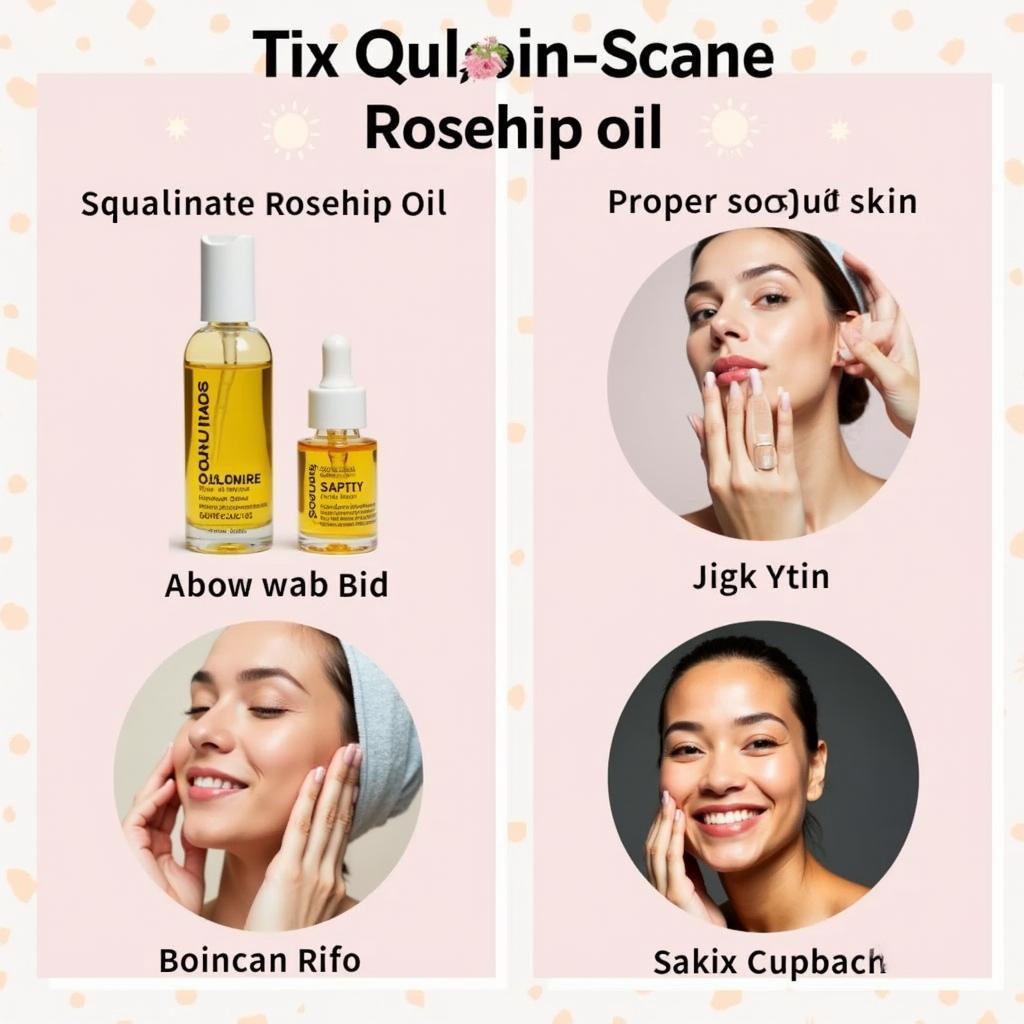
Squalane vs Rosehip Oil: Which is Right for Your Skin?
- AmazoniaSilva
- Tháng 1 14, 2025
- Zodiac signs
- 0 Comments
Squalane Vs Rosehip Oil – two popular skincare ingredients that often cause confusion. Both are lauded for their hydrating and nourishing properties, but which one comes out on top? This comprehensive guide dives deep into the differences between squalane and rosehip oil to help you determine the perfect choice for your unique skin needs.
Understanding Squalane: The Skin’s Natural Moisturizer
Squalane is a saturated and stable form of squalene, a lipid naturally produced by our skin. As we age, our natural squalene production decreases, leading to dryness and a compromised skin barrier. Supplementing with squalane can help replenish this vital lipid, restoring hydration, softness, and suppleness. Squalane is lightweight, non-comedogenic, and readily absorbed, making it suitable for even the most sensitive skin types.
Benefits of Squalane:
- Intense Hydration: Squalane effectively locks in moisture, preventing water loss and keeping skin hydrated.
- Improved Skin Barrier Function: It strengthens the skin’s protective barrier, shielding it from environmental aggressors.
- Reduced Appearance of Fine Lines and Wrinkles: By maintaining hydration and promoting skin elasticity, squalane can minimize the appearance of aging.
- Non-Irritating and Suitable for Sensitive Skin: Its gentle nature makes it an excellent choice for those with reactive skin.
Do you have oily skin and worry about breakouts? Squalane is non-comedogenic, meaning it won’t clog pores.
Exploring Rosehip Oil: The Vitamin-Rich Antioxidant Powerhouse
Rosehip oil is extracted from the seeds of the rosehip fruit. It’s rich in vitamins A, C, and essential fatty acids, making it a potent antioxidant and anti-inflammatory agent. Rosehip oil is known for its ability to brighten skin tone, reduce the appearance of scars and hyperpigmentation, and improve overall skin texture.
Benefits of Rosehip Oil:
- Brightens and Evens Skin Tone: Vitamin C helps fade dark spots and hyperpigmentation, promoting a more radiant complexion.
- Reduces the Appearance of Scars and Stretch Marks: Its regenerative properties can help minimize the appearance of scars and improve skin texture.
- Anti-inflammatory and Soothing: Rosehip oil can calm irritated skin and reduce redness.
- Boosts Collagen Production: Vitamin A stimulates collagen synthesis, improving skin elasticity and firmness.
What if you have acne-prone skin? Rosehip oil’s anti-inflammatory properties may help reduce inflammation associated with breakouts. However, it’s always advisable to do a patch test before applying it to your entire face.
Squalane vs. Rosehip Oil: Head-to-Head Comparison
Choosing between squalane and rosehip oil depends on your specific skin concerns and goals. rosehip oil vs squalane Here’s a quick breakdown:
- For Dry, Dehydrated Skin: Squalane is an excellent choice for providing intense hydration and restoring the skin barrier.
- For Acne-Prone or Sensitive Skin: Squalane’s non-comedogenic and gentle nature makes it suitable for sensitive and acne-prone skin.
- For Dull, Uneven Skin Tone and Scarring: Rosehip oil’s vitamin C content can help brighten skin and reduce the appearance of scars and hyperpigmentation.
- For Mature Skin: Both oils can be beneficial for mature skin. Squalane improves hydration and reduces fine lines, while rosehip oil boosts collagen production and improves skin texture. Combining both oils can provide a comprehensive anti-aging approach.
 Rosehip Oil and Squalane in Skincare Routine
Rosehip Oil and Squalane in Skincare Routine
“Rosehip oil is a game-changer for addressing hyperpigmentation and achieving a more even skin tone,” says Dr. Amelia Garcia, a renowned dermatologist. “Its high concentration of Vitamin C works wonders in fading dark spots and promoting a radiant complexion.”
Conclusion: Combining the Power of Squalane and Rosehip Oil
Ultimately, the best approach might be incorporating both squalane and rosehip oil into your skincare routine. Squalane provides a base layer of hydration, while rosehip oil delivers targeted benefits for specific skin concerns. Squalane vs rosehip oil? Perhaps it’s not about choosing one over the other, but about harnessing the power of both for healthy, glowing skin. face oil rollerball
FAQ
- Can I use squalane and rosehip oil together? Yes, you can layer these oils for enhanced benefits.
- Is rosehip oil suitable for all skin types? While generally well-tolerated, a patch test is recommended, especially for sensitive skin.
- What is the best time to apply these oils? Both can be applied morning and night after cleansing and toning.
- Can I use these oils with other skincare products? Yes, they can be incorporated into your existing skincare routine.
- Where can I buy high-quality squalane and rosehip oil? Look for reputable brands that offer cold-pressed, organic options.
“For optimal hydration and a healthy skin barrier, squalane is essential,” adds Dr. Garcia. “Its compatibility with all skin types makes it a versatile addition to any skincare regimen.” ice ball for face
For further assistance, please contact us via Email: [email protected], or visit our office at Fifth Avenue, 34th Floor, New York, NY 10118, USA. We offer 24/7 customer support.

